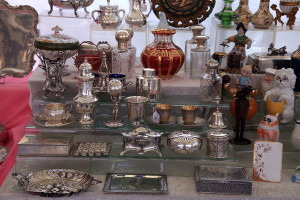 At an Estate Sale, you’ll find all kinds of things; from simple trinkets to pricey antiques. Pictures and kitchen appliances, jewelry and clothing, even sports memorabilia. In fact, the last Northridge Estate Sale boasted hundreds of personally signed items from footballs to basketballs, jerseys to boxing gloves. Astounding!
At an Estate Sale, you’ll find all kinds of things; from simple trinkets to pricey antiques. Pictures and kitchen appliances, jewelry and clothing, even sports memorabilia. In fact, the last Northridge Estate Sale boasted hundreds of personally signed items from footballs to basketballs, jerseys to boxing gloves. Astounding!
When it comes to memorabilia, we don’t often make guarantees that signatures are authentic, but some items do come with a Certificate of Authenticity (COA). Wouldn’t it be wonderful if everything for purchase came with one of those? Something that promised the Rolex was really a Rolex, the Kate Spade purse was really from Kate Spade, or the silver chain was real silver and not just plated.
Sterling Or Plated
When it comes to a silver piece, you’ll find that there are two options for the material type. The item might be sterling silver (referred to as “real” silver) or it might be silver plated. Sterling silver is worth more money than a silver plated item, but it can be difficult to tell the difference. Taking your item to a jeweler for inspection is the best way to know the value of what you are dealing with. However, if you are at an Estate Sale, you won’t be able to borrow an item to be inspected before purchase. You’ll just have to take the hosts word for it, or take your chances.
There are a few ways that you might be able to tell if you have sterling or plated silver without a costly and untimely trip to the jewelers.
Check It
A simple inspection of the item might be helpful. True sterling silver will be stamped with a mark such as:
• Sterling Silver
• .925 (or a higher number)
• A Lion Hallmark
If you do not see one of these marks, you are most likely looking at a plated piece. Most silver plated items might be unmarked or marked with the words:
• Silver Plate
• Plated
• EP (electroplated)
• EPNS (electroplated nickel silver)
Ice It
Silver has an extremely high thermal conductivity rate. This means that it will become very cold very quickly when you put the item on ice. Or, when you place an ice cube on a piece of silver, the ice will melt faster than if you put it on a different surface. If you happen to have a cold drink with you at the sale, you might be able to use this method.
Stick It
Carry a magnet with you to an Estate Sale and it just may help you determine if your silver is really silver. Real silver is not magnetic. If you use a strong magnet, called a Neodymium magnet, on the surface of the silver item, it should not stick. If your magnet does stick, it is not silver.
But just because it doesn’t stick it doesn’t mean that it is silver; it just means that it might be and that more tests will help in the determination.
Now that you have an idea on how to spot the silver, it’s time to go out and look for some! Heritage Estate Sales hosts sales almost every week. Some are open to anyone and some are by appointment only, but you can check out our website to find one near you. Happy hunting!
